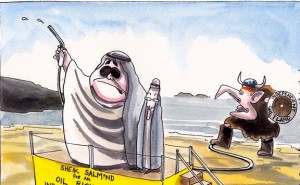Robert Rapier writes, A decade ago Conoco/Philips ratio between proved oil reserves and production rate was 10 years. ConocoPhillips today has 8.9 billion barrels of oil equivalent (BOE) and its production rate was 1.5 million BOE/day. Thus, the R/P has grown to 16.3 years. In fact, according to the 2014 BP Statistical Review of World Energy, the R/P ratio for the U.S. as a whole was 12.1 years at the end of 2013. Twenty years ago, the R/P ratio in the U.S. was only 9.6 years.
Think about the implications of that. In 1993 the U.S. had enough proved reserves to produce at the then-current rate for 9.6 years. Not only did we continue to produce for 9.6 years, today’s production rate is 17% higher than it was in 1993, and yet we now have enough oil to produce for 12.1 years at current rates. And the world as a whole has a R/P ratio of 53 years.
In fact, if I go all the way back to 1965, U.S. proved reserves were 31 billion barrels. Between then and now — a span of 49 years — the U.S. produced 163 billion barrels of oil, and today our proved reserves are 44.2 billion barrels of oil. Globally proved reserves have grown steadily for more than three decades:

How did this happen?
It basically comes down to three things. The first is that obviously more oil was found. For example, in 1965 Alaska’s Prudhoe Bay and its 25 billion barrels of oil had yet to be discovered.
The second is that technologies for recovering oil from existing fields improved. Shell geophysicist M. King Hubbert is often credited with correctly predicting in a 1956 paper that U.S. oil production would peak in 1970. What many don’t realize is that this was a secondary prediction. He actually predicted that U.S. oil production would peak in 1965. U.S. would have to find additional oil fields equivalent to “eight East Texas oil fields.” But those oil fields continue to be “found” by applying new recovery technologies to producing fields and increasing the recovery percentage.
The third factor comes down to the way proved reserves are defined. The oil must be estimated with reasonable certainty, from the analysis of geologic and engineering data, to be recoverable from well established or known reservoirs with the existing equipment and under the existing operating conditions.” Undeveloped reserves can also be booked as proved provided there is a development plan for drilling within five years.
These three factors explain why oil production has far outstripped what expectations might have been given estimates of proved reserves in the past. Today’s R/P ratio in the U.S. of 12.1 years is really a reflection of the oil development that is in the pipeline at current prices. In recent years, U.S. reserves have gone up as higher prices made shale oil economical to produce.
There is a lot more uncertainty about the global reserves figure. But it is safe to say that we will be using oil for decades to come, and when we do move on to something else there will still be plenty of crude left in the ground.

